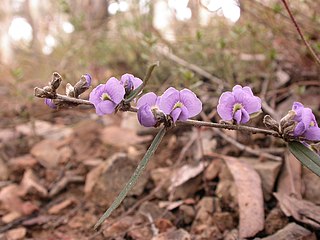
Hovea heterophylla, commonly known as creeping hovea, is a small shrub with linear leaves and purple-violet pea flowers. It is found in all states other than Western Australia.

Hovea pannosa is a species of flowering shrub in the family Fabaceae and is endemic to Australia. It is a small, erect shrub with purple pea flowers and stiff green leaves.

Hovea acanthoclada, commonly known as thorny hovea, is a flowering plant in the family Fabaceae. It is an upright, prickly shrub with small dark green leaves and purple-blue pea flowers in winter and spring. It is endemic to the south-west of Western Australia.
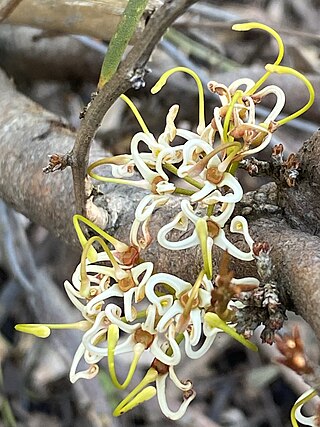
Hakea platysperma, commonly known as the cricket ball hakea, is a shrub in the family Proteaceae. It has long, sharply pointed, needle-shaped leaves and fragrant cream-reddish flowers in clusters from July to October. It is endemic to the south west of Western Australia.

Leionema elatius, commonly known as tall phebalium, is a shrub species that is endemic to New South Wales and Queensland in Australia. It has glossy green, variably-shaped leaves and clusters of white-lemon flowers in spring.

Hovea lanceolata is a flowering plant in the family Fabaceae. It is a small shrub with elliptic leaves and purple pea flowers. It grows in New South Wales and Queensland.

Hovea montana, commonly known as alpine hovea, mountain hovea or alpine rusty-pods, is a flowering plant in the family Fabaceae, and is endemic to Australia. It is a small shrub with narrow leaves and purple pea flowers.

Hakea tuberculata is a flowering plant in the family Proteaceae and is endemic to several isolated areas along the coast in the Peel, South West, Great Southern and Goldfields-Esperance regions of Western Australia. It is an upright shrub with white flowers and rigid, prickly leaves.

Hakea obliqua, commonly known as needles and corks, is a shrub in the family Proteaceae and is endemic to an area in the Wheatbelt, Great Southern and Goldfields-Esperance regions of Western Australia.

Hovea pungens, commonly known as devil's pins, is a species of flowering plant in the family Fabaceae and is endemic to Western Australia. It is a small, upright shrub with dark green leaves and purple flowers.

Hovea stricta is a flowering plant in the family Fabaceae and is endemic to the south-west of Western Australia. It is a small, upright shrub with mostly purple flowers, green needle-shaped leaves and flowering occurs in winter and spring.

Hovea longifolia, commonly known as rusty pods, is a flowering plant in the family Fabaceae, endemic to eastern Australia. It has purple pea flowers, linear leaves with rusty felt like hairs on the lower surface.
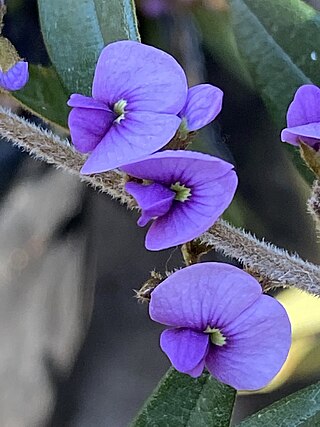
Hovea acutifolia, is a species of flowering plant in the family Fabaceae. It is an upright, small shrub with blue to purple pea flowers, dark green leaves and rusty coloured new growth. It grows in Queensland and New South Wales.
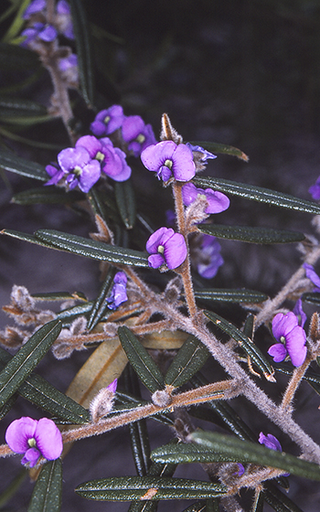
Hovea purpurea, commonly known as velvet hovea, is a flowering plant in the family Fabaceae. It is an upright shrub with narrow leaves, purple pea flowers and stems with matted hairs. It grows in New South Wales, Victoria and South Australia.

Hovea speciosa is a flowering plant in the family Fabaceae, endemic to eastern Australia. It has purple pea flowers, linear leaves with long, rusty hairs on the lower surface. It is endemic to New South Wales.
Scaevola collina, is a species of flowering plant in the family Goodeniaceae. It is a small sub-shrub with blue to purplish flowers. It grows in South Australia.
Scaevola chrysopogon is a species of flowering plant in the family Goodeniaceae. It is a small, understorey shrub with fan-shaped cream or white flowers and is endemic to Western Australia.

Hovea pedunculata, is a species of flowering plant in the family Fabaceae. It is an small shrub with mauve flowers, dark green leaves and rusty coloured new growth. It grows in Queensland and New South Wales.
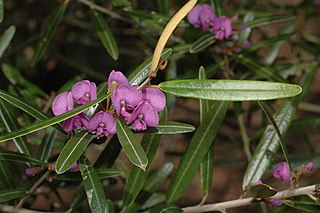
Hovea lorata, is a species of flowering plant in the family Fabaceae and is endemic to eastern Australia. It is a shrub with lorate (strap-shaped) leaves, and mauve and greenish-yellow, pea-like flowers.
Hovea magnibractea, is a species of flowering plant in the family Fabaceae and is endemic to south-eastern Australia. It is a shrub with narrowly oblong to lorate (strap-shaped) leaves, and mauve and yellow, pea-like flowers.

















